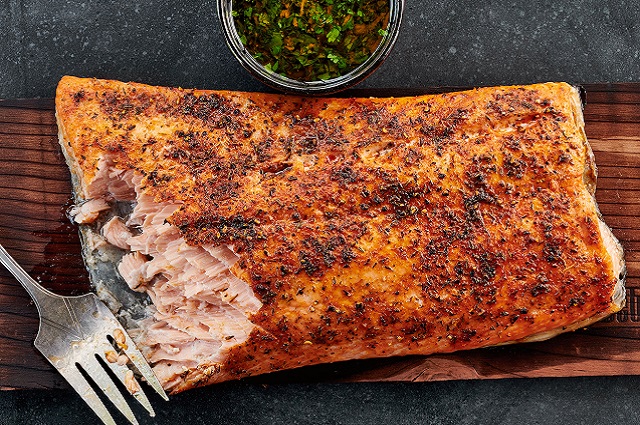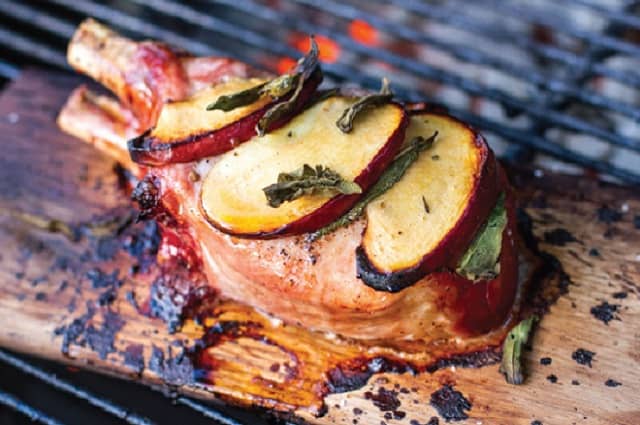Cooking meats on a wooden board is an old tradition. Some believe it originated with the Native American tribes of the Pacific Northwest. Others believe the practice originated in Scandinavia.
For the backyard chef, it matters little who was the first to cook meat on a wood plank. Plank cooking is easy, it can be used for meats, fish, vegetables, cheese and even fruit. It can be a nice change of pace as you experiment with this unique process, impressive presentation and enjoy the wood-infused flavor.
Grilling on a hardwood plank keeps your food away from the direct heat of the grill. The plank serves as a heat shield and helps flavor your food. The incredible smoky flavors of wood such as Western Red Cedar, Alder, Sugar Maple, Hickory, Mesquite and Oak from old wine barrels can be infused into your favorite foods as you grill or bake.
You can purchase planks at your local hardwood store. As long as the wood is clean, untreated and one of the species mentioned above, it should be safe to cook on. Use thick planks because they are less likely to catch fire while cooking, and they are reusable for at least a couple of cooking sessions. Thick planks are also less likely to warp.
Plank Cooking Tips
- Soak the plank in water for at least 30 minutes before putting it on the grill. Make sure the plank is fully submerged by putting a heavy pot on top of it.
- Depending on what you’re grilling, try different types of untreated wood planks — cedar, oak, alder, hickory, maple, cherry and apple.
- If cooking fish with the skin on, spray or brush the skin with cooking oil before placing it on the plank.
- Place fresh herbs between the plank and your meat or fish. Cook vegetables on the same plank as your protein. Serve directly on the plank.
- Rotate and reposition planks as needed for even cooking. For some foods, like steak, you may want to flip the food on the plank halfway through cooking.
- Use a spray bottle of water to put out any flare-ups or flames on the plank if it starts to burn.
- It will take longer for your food to cook because it will not be directly above the heat. If using a gas grill, turn half of the burners on. If using a charcoal grill, place the charcoal on one side of the grill.
- Place the plank in water after grilling because a heated plank can contain glowing embers that could reignite.
- You can reuse a grilling plank two or three times. Rinse well with water, and then put the plank back into a hot grill for at least 10 minutes to kill any bacteria. It is recommended that a plank used to grill fish should only be reused to cook more fish.
Planked Salmon with Gremolata

1 skin-on, center-cut salmon fillet, 1 1/2–2 pounds and 3/4–1-inch thick, pin bones removed
2 teaspoons extra-virgin olive oil
for gremolata sauce:
1/4 cup extra-virgin olive oil
finely grated zest of 1 orange (about 1 tablespoon)
2 tablespoons fresh orange juice
1/4 cup chopped fresh cilantro
1 tablespoon capers, rinsed and drained
1/2 teaspoon kosher salt
1/4 teaspoon ground black pepper
for spice rub:
1/2 teaspoon kosher salt
1/2 teaspoon smoked paprika
1/4 teaspoon dried thyme, crushed between your fingertips
1/4 teaspoon ground cumin
1/4 teaspoon ground black pepper
Submerge the cedar plank in water and let soak for at least 1 hour and up to 1 day. This step is important, as it prevents the wood from catching on fire. Use a medium bowl filled with water or a couple of cans of beer to weight the plank down.
For the sauce, whisk together the oil, orange zest, and orange juice in a small bowl. Stir in the cilantro, capers, salt, and pepper. Set aside.
In a small bowl, combine all the rub ingredients and mix well.
Place the salmon on a work surface, skin side down. Coat the salmon flesh with the oil and season evenly with the rub.
Prepare the grill for direct cooking over medium-high heat (400°–450°F). Brush the cooking grates clean. Drain the cedar plank. Place it over direct heat and close the lid. When the plank begins to smoke and toast, after 3–10 minutes, use long-handled tongs to turn it over. Slide the salmon, skin side down, onto the toasted side of the plank.
Grill over direct medium-high heat, with the lid closed, until the salmon is cooked to your desired doneness, 15–30 minutes (depending on the thickness) for medium-rare (125°–130°F on an instant-read thermometer).
To serve, transfer the fillet from the plank to a heatproof surface. Cut crosswise into four portions and serve with the sauce.
Planked Pork Chops with Apple, Sage & Cider Reduction

1 double-bone pork chop (this works with any pork chop, but the double bone looks awesome)
1/2 teaspoon freshly ground pepper
1/2 teaspoon kosher salt
1/2 teaspoon paprika
1 apple, cut into ¼-inch slices
2 bunches of sage
1 bottle of Angry Orchard Ginger Cider
1 teaspoon apple cider vinegar
1 wood plank (I used red oak but anything will work)
SUBMERGE plank in shallow pan of water for an hour. Prepare grill for direct and indirect medium heat.
STIR together salt, pepper, and paprika. Rub both sides of chop with mixture. Lay chop on plank. Top with 3 or so apple slices and sage leaves.
SET PLANK over direct heat. After 20 minutes, move to indirect side of the grill.
WHILE CHOP IS GRILLING, in a sauce pan, boil 12-ounces of cider over high heat until only 6 ounces remain. Stir in the apple cider vinegar and set aside.
BY THE TIME that reduction is done, the plank should be on the indirect part of the grill. Cook chop until it reaches 145°F. During the last 5 minutes, brush with cider reduction. Once done, remove from the grill and allow to rest for at least 5 minutes.
PLATE with additional apple slices (grilled, if you prefer) and top with remaining cider reduction.
Cedar-Planked Brie Crostini

Leaves picked from 24 sprigs of fresh thyme, about one ½-ounce package
2 tablespoons fresh lemon juice
3 tablespoons honey
Hazelnut oil
Fine gray sea salt
1 French baguette
2 Fuji apples
1 wheel triple-cream brie, about 20 ounces
1 cedar plank
For the Thyme Honey Sauce: Combine the thyme leaves, lemon juice and honey with 2 tablespoons of hazelnut oil and a pinch of salt in a small bowl. Process to a smooth emulsion using an immersion blender. Cover tightly and refrigerate until use.
Prepare grill for indirect grilling with an air temperature of 400°F.
Cut the baguette on the bias into thin slices. Brush both sides of each slice with hazelnut oil, then season one side with salt. Place all the slices on a couple of wire cooling racks and place the racks in the grill. Toast the bread in the indirect zone of the grill with the lid closed until crunchy on the outside, about 3 minutes.
Cut the apples into thin slices and set aside.
To Prepare the Cheese: Lightly brush the top of the cedar plank with hazelnut oil. Place the wheel of the brie in the center of the oiled plank, then transfer the plank to the indirect zone of the grill. Close the lid and cook the plank is smoking and the brie is melted (the sides of the wheel begin to collapse), about 10 minutes.
Serve family style: Transfer the hot plank to a heat-proof serving tray. Use a knife to break open the rind on the cheese. Top the cheese with Thyme Honey Sauce and serve with the crostini and apples. Guests can lay a slice of apple on top of a slice of bread and then use the bread to scoop the melted cheese and sauce.
To serve in a less messy manner: Assemble the crostini before serving. Add a slice of apple to a slice of bread. Spread melted cheese on top and then drizzle with Thyme Honey Sauce.


